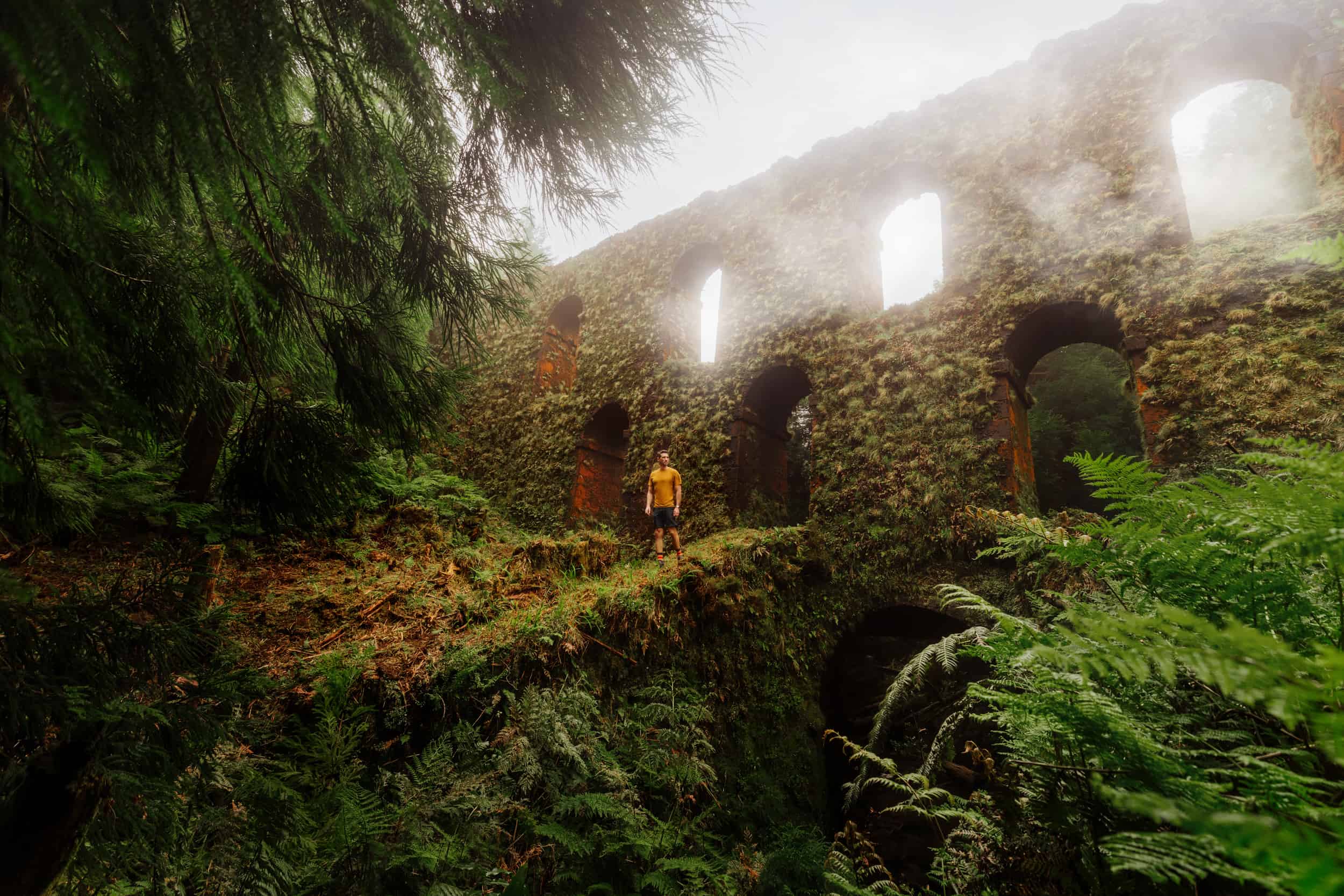The Best Time to Visit the Azores: The Ultimate Seasonal Guide

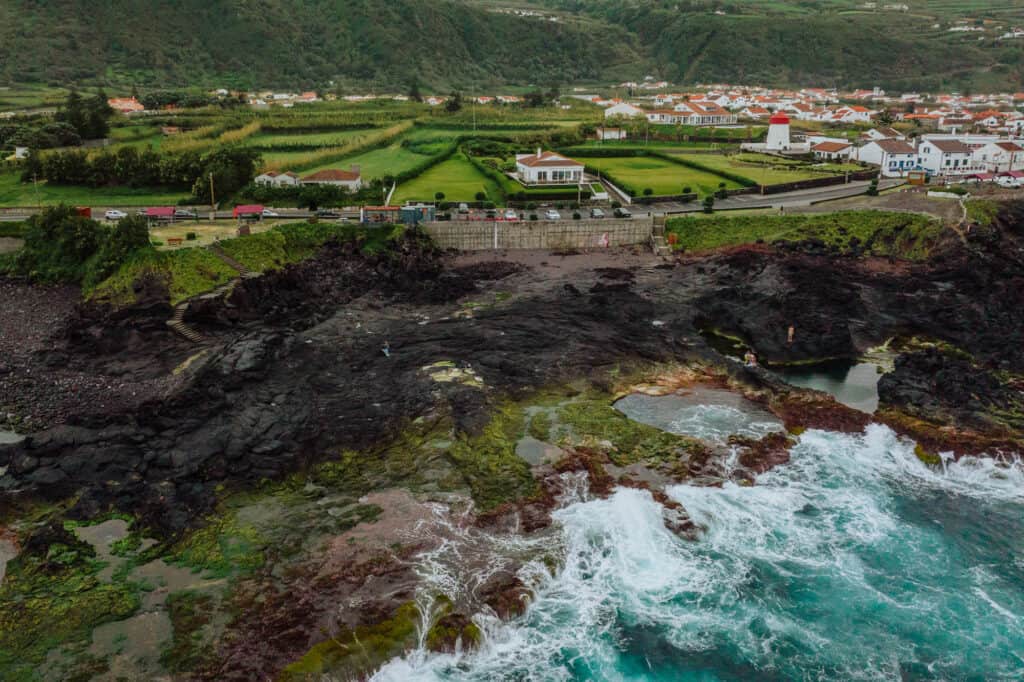
THE BEST TIME TO VISIT THE AZORES
Right off the bat, I’m going to give you an easy answer: May or September are the best months to visit the Azores! My opinion is based solely on my desire for warm days, mostly-dry hiking trails, and smaller crowds of tourists.
With that said, there are perks to visiting the Azores at different times of the year, depending on what you’re looking to do. I’ve broken this post up into different sections, so let the table of contents guide you to the information you’re looking for.

Renting a car is the best way to experience the Azores!
No matter the time of year you visit the Azores, renting a car is the best way to see all the islands have to offer.
I use Discover Cars when I book, because they include the local rental agencies, in addition to the big international car rental brands.
OK: Let’s Find Your Best Time to Visit the Azores!
Seasons in the Azores
Let’s break down the weather by season in the Azores.
KEY INFO: It never snows in the Azores!
Spring in the Azores
March, April, and May are popular months to visit the Azores. The weather is mild, and the islands’ landscapes come to life with colorful flowers and lush greenery. It’s a great time for hiking and exploring nature.
Summer in the Azores
The summer months of June, July, and August are the peak tourist season. The weather is warm, and perfect for hiking and spending time at the beaches. Some of the trails can get pretty crowded, and you might pay a premium for lodging and rental cars.
Fall in the Azores
September, October, and even November are still pretty mild months in the Azores. The summer crowds are gone. While it might be too cold for the beaches, you can still enjoy hiking and other outdoor activities in autumn.
Winter in the Azores
Winters in the Azores are mild compared to many other regions, with temperatures rarely falling below 10°C (50°F). It’s a great time for travelers who prefer smaller crowds, and pay lower prices for lodging.
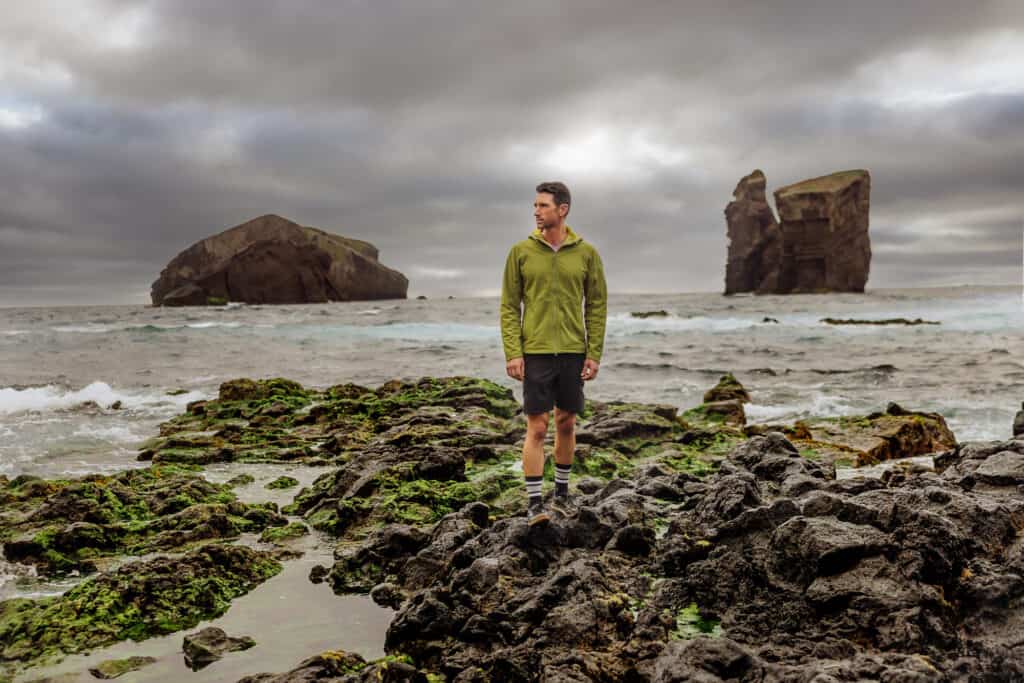
Azores Tours in Any Season
These tour options all come highly recommended!
➡️ Click to Book: Private Tour: Sao Miguel
- Full Day from Ponta Delgada
➡️ Click to Book: Azores Canyoneering
- Waterfall Adventure
- For a group off Ponta Delgada
➡️ Click to Book: Fishing Trip
- Off Sao Miguel
➡️ Click to Book: Azores Wine & Cheese
- Tastings in Ponta Delgada
➡️ Click to Book: Sao Miguel Day Tour
- Sete Cidades & More
- Ponta Delgada

Rainfall in the Azores
It’s important to note that these are average rainfall amounts, and actual weather conditions can vary from year-to-year. Rainfall is largely driven by the oceanic climate, which seems to be in flux these days.
Plus, parts of Sao Miguel and the other Azores Islands have their own microclimates, so different regions will experience different rainfall patterns.

Consider this a general guide to the average rainfall amounts in the Azores by season:
Spring Rainfall in the Azores
- Spring is generally a wet season on Sao Miguel Island.
- Average rainfall: Around 4-6 inches per month.
- March and April tend to be rainier, with showers and occasional thunderstorms, while May starts to see a decrease in rainfall.
Summer Rainfall in the Azores
- Summer is the driest season on the islands, but rainfall is still possible.
- Average rainfall: Around 2-4 inches per month.
- July and August are typically the driest months in the Azores, with fewer rainy days and more sunshine.
Fall Rainfall in the Azores
- Fall experiences a gradual increase in rainfall as the season progresses.
- Average rainfall: Around 4-6 inches per month in September and October, increasing to 6-8 inches in November.
Winter Rainfall in the Azores
- Winter is the wettest season on Sao Miguel Island.
- Average rainfall: Around 6-8 inches per month.
- December and January tend to be the wettest months in the Azores.
The Best Time to Hike in the Azores
The best time to go hiking on Sao Miguel and the other Azores Islands is a matter of personal opinion. For me, it would be May or September. The weather is mild and dryer, the days are longer, and the island’s vegetation is lush and vibrant.
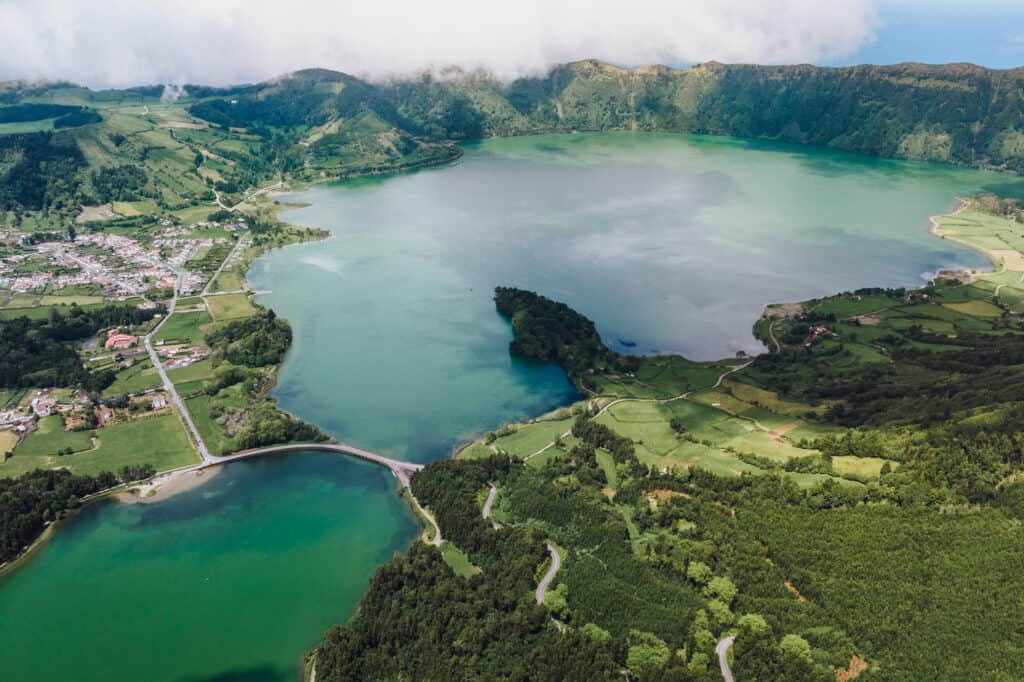
During the summer months (June, July, and August), hiking is still amazing in the Azores, but you’ll have to be prepared for some crowded trailheads.
I’d recommend these tour options for hikes on Sao Miguel:
➡️ Click to Book: Sao Miguel Hike
- Volcanic lakes
➡️ Click to Book: Sete Cidades Hike
- Sete Cidades
➡️ Click to Book: Azores Waterfall Hike
- Salto do Prego.

The Best Time for Flowers in the Azores
The best time to visit Sao Miguel for flower blooms is from mid-to-late May, through June. The island’s flowers reach their peak during that period, but from April through the summer, you’ll always find something beautiful and in bloom!

By late March and early April, you can witness the early spring blooms, including azaleas, camellias, and other wildflowers. As the season progresses into May and early June, the landscapes become even more stunning, with hydrangeas, rhododendrons, and other flowering plants in full bloom.
Sao Miguel is famous for its huge hydrangea plants, seemingly growing like weeds along hiking trails and highways!

The Best Time to Visit the Azores on a Budget
With patience and planning, you can usually find decent deals for a budget-friendly trip to the Azores.
Flight prices usually start dropping after the summer high season, in September. They can fall even lower, deeper into the winter and early spring months.
You’ll find amazing hotel deals in December and January. Rooms that can run $500 a night, drop down into the $100s at some of the top Azores resorts and hotels, including the tranquil Sensi Azores Natural and Spa on the west coast of Sao Miguel.
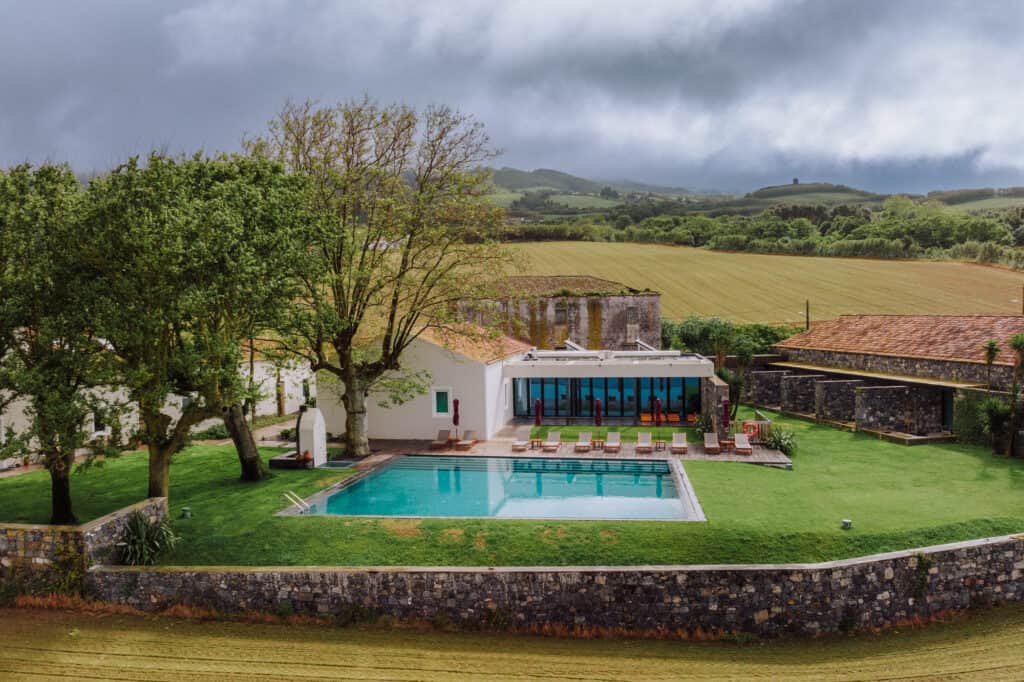
Flight Deals to the Azores
When it comes to finding the best deals on flights to the Azores, you’ll have to search around. During the off-season (October through March) some airlines have been known to cut back their service to the Azores. While you might have fewer flight options, the fares will be lower.
Start searching for flights around the dates you’re looking to visit the Azores several months in advance. If you see a deal for your dates, snag it.
There are usually direct flights to Ponta Delgada’s airport (PDL) from Boston, Newark, New York’s JFK, and Toronto. In addition to searching those options on United and Azores Airlines, search for lower-cost flights to Lisbon. From Lisbon, you can usually find cheap hopper flights to the Azores on Ryanair, TAP, and Azores Airlines.
Aside from Lisbon, check for deals to major European hubs, like Paris, London, and Madrid. You’ll be able to find cheap hopper fares to the Azores from those big cities, too.

The Best Time to Visit the Beaches in the Azores
While the Azores resemble the volcanic Hawaiian Islands in many ways, you won’t find many pristine white sand beaches here in the North Atlantic. The swimming season is short, and the coastline is largely made of black volcanic rocks.
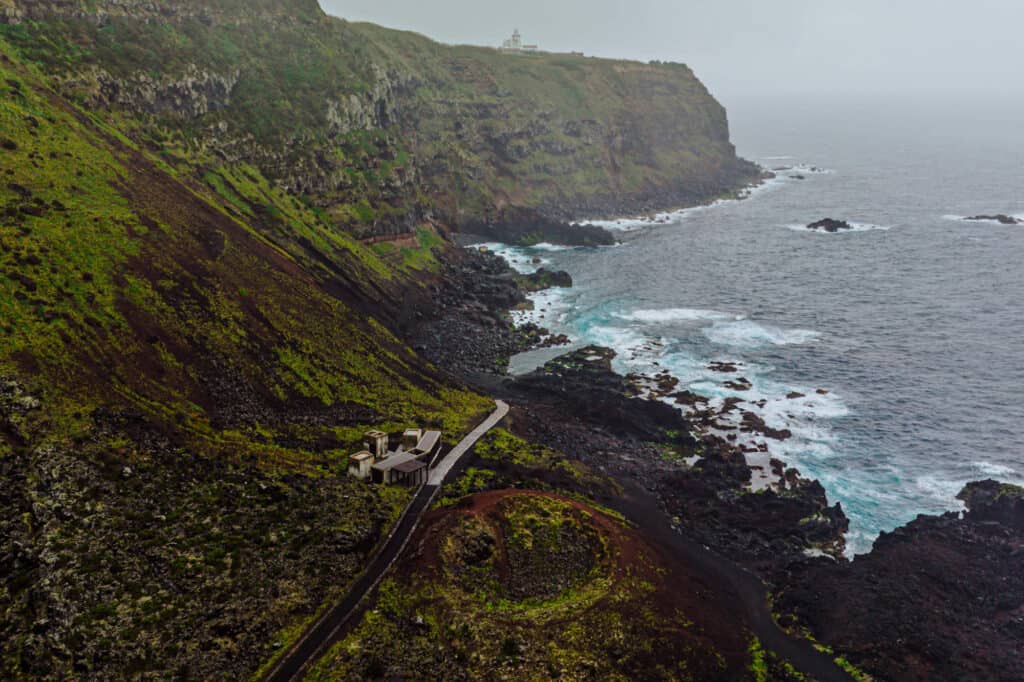
Still, the Azores’ beaches offer stunning views, and are often surrounded by jagged cliffs.
The ocean water temperature off the coast of Sao Miguel and the other Azores islands might be too cold to enjoy, depending on what you’re used to:
Spring Water Temperature
- Average water temperature: 16°C to 18°C (61°F to 64°F)
- The ocean temperature around the Azores starts to warm up during the spring, but is still cool.
Summer Water Temperature
- Average water temperature: 19°C to 22°C (66°F to 72°F)
- Of course, summer is the warmest season for the ocean water around the Azores. The water is almost pleasant for swimming and water activities.
Fall Water Temperature
- Average water temperature: 19°C to 22°C (66°F to 72°F) in September, gradually decreasing to 17°C to 19°C (63°F to 66°F) in November.
- The water remains relatively warm during the early fall but starts to cool down as the season progresses.
Winter Water Temperature
- Average water temperature: 16°C to 18°C (61°F to 64°F)
- Winter brings cooler ocean temperatures, but it’s still relatively mild compared to other regions. A wetsuit is recommended!
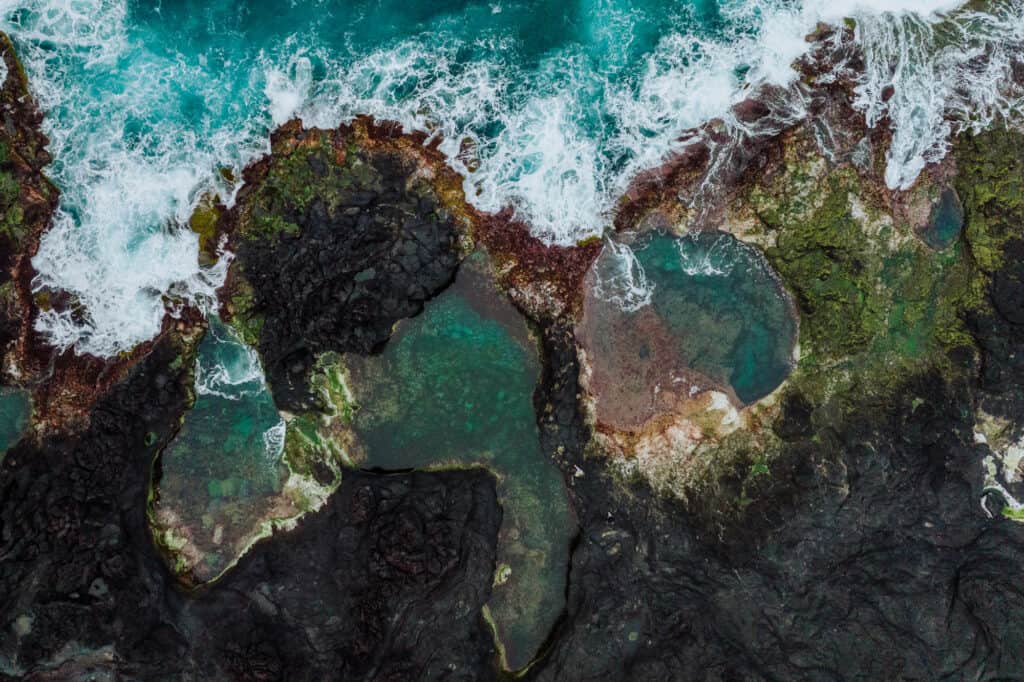
The Best Time for Surfing in the Azores
The best time to surf in the Azores is during the fall and winter months, when the Atlantic Ocean produces larger swells. The Azores Islands experience more consistent and powerful waves during the winter.
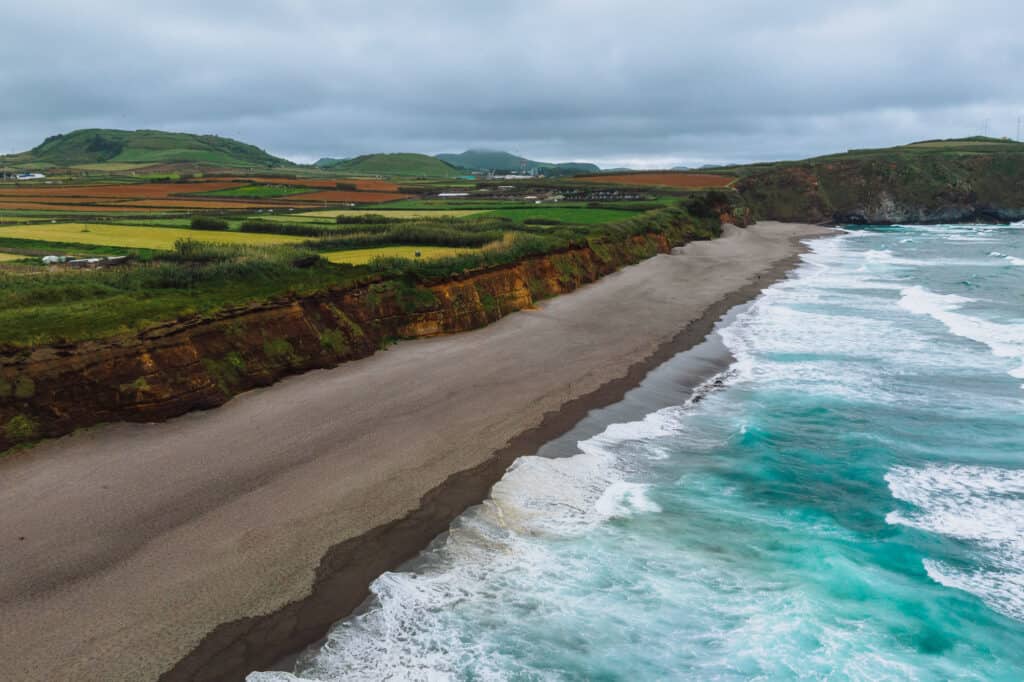
Fall is great for both intermediate and experienced surfers, as the waves are generally more manageable.
It goes without saying, but: make sure to bring a wetsuit to stay comfortable while surfing!
If you’re are a beginner, or prefer more relaxed surfing conditions, you can still enjoy surfing in the Azores during the spring and summer months when the water temperatures are warmer
If you’re really into surfing, you likely already know to check out Nazare on mainland Portugal. It’s an easy drive from Lisbon, and home to some of the biggest, record-setting waves on the planet!
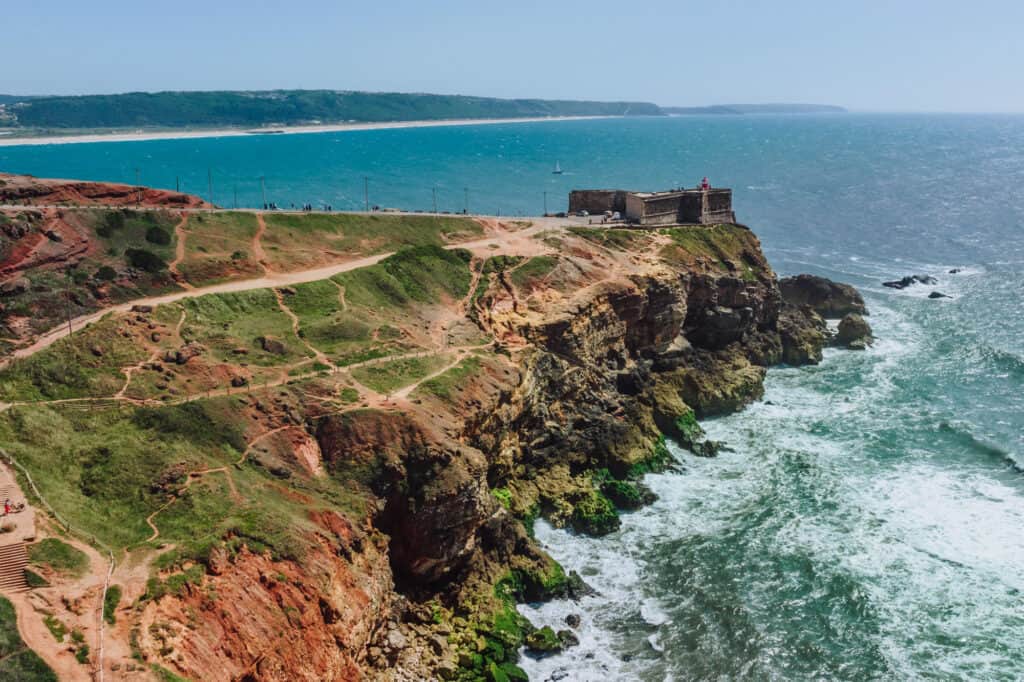
The Best Time for Whale Watching in the Azores
The best time to go whale watching in the Azores is during the spring and summer months, from April to September. During this period, several whale species migrate through or inhabit the surrounding waters.
➡️ Click to Book: Azores Whale Watching
- Full-Day Tour
➡️ Click to Book: Azores Whale Watching
- Half-Day Tour
➡️ Click to Book: Pico Island Whale Watching
The island of Pico is one of the best places in the world to see sperm whales. The underwater geography creates a nutrient-rich environment that sustains a diverse marine ecosystem, making it an excellent feeding ground for the whales.

When visiting Pico Island for sperm whale watching, you’ll likely depart from the town of Lajes do Pico, which is renowned for its whale-watching tours and experienced guides.
Some of the most commonly spotted whales off the Azores include:
- Sperm Whales: The Azores are one of the best places in the world to see sperm whales year-round. Their sightings are more frequent from April through September.
- Blue Whales: The largest animals on Earth, blue whales, can be seen in the Azores during the spring and summer months, particularly in May and June.
- Humpback Whales: Humpback whales are typically seen in the Azores during their migration from April to June.
- Fin Whales: Fin whales are also seen during the migration season, with higher chances of spotting them from April to June.
- Sei Whales and Minke Whales: These whales are present in the Azores during the spring and summer months, providing additional opportunities for whale watching.

The Azores Weather by the Month
The Azores in January
Be prepared for rain and cooler temperatures if you’re visiting the Azores in January. The weather can be messy and unpredictable, but remember: it never snows in the Azores!
As for some of the perks of visiting the Azores in January, you’ll find far fewer tourists, since it’s the off-season. The hiking trails and viewpoints will be mostly empty, so it’ll be a quieter experience (but also probably rainier).
January is also a great time to visit the Azores on a budget! You’ll find great discounted rates at beautiful hotels, like Sensi Azores Natural and Spa.
Plus, let’s face it: January in much of the world is cold and miserable. It’s at least still relatively mild in the Azores!
Plus, the hot springs and thermal baths are still pumping out hot water. January is a great time to relax and rejuvenate in the warm waters.
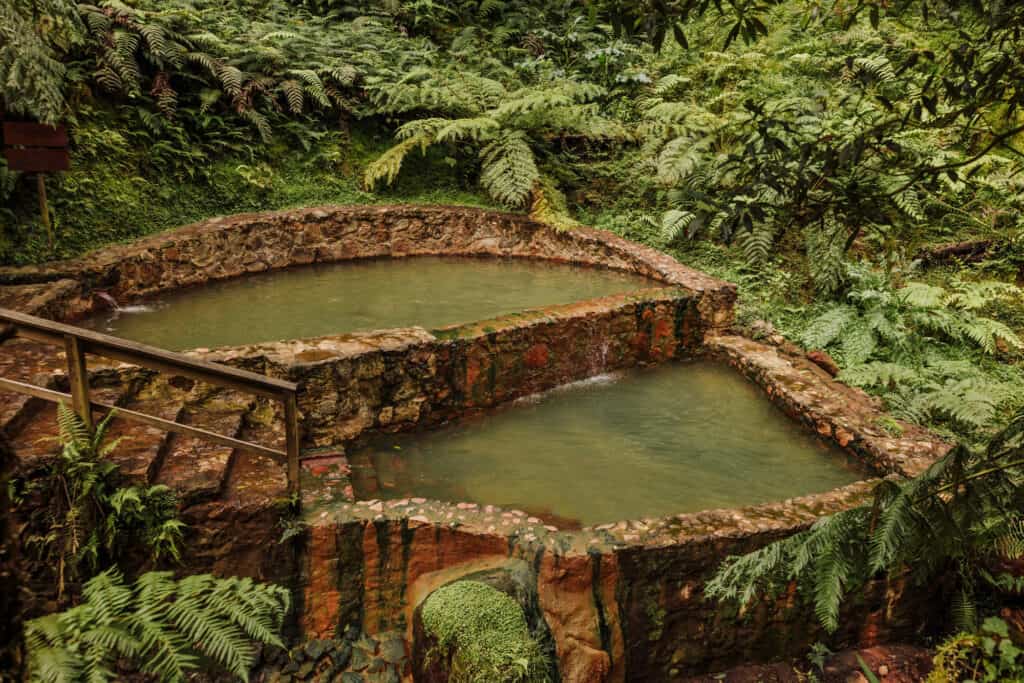
The Azores in Feburary
Visiting the Azores in February comes with a few perks.
It’s still off-peak tourist season, so you’ll find smaller crowds at the viewpoints and on the hiking trails. Plus, the deals on off-peak accommodations continue, and you’ll have an abundance of rental car options. It’s a great time for budget travel to the Azores.
While the weather is cooler and rainier in February, you’ll still find lush green landscapes to explore, and thermal baths and hot springs to warm up in.
I have no experience bird-watching, but I’m told February is an excellent time for birdwatching in the Azores. The islands serve as an essential stopover for migratory birds, providing opportunities to observe a variety of species.
The Azores in March
Visiting the Azores in March can be a mixed bag. It marks the beginning of the spring season, meaning: more mild weather. Keep in mind: it can still be unpredictable and rainy. As always, pack layers and waterproof clothing to be prepared for a variety of conditions.
The lush landscaping in the Azores starts to come alive in March, but it’s still considered off-peak season for tourism. That translates to small crowds and deals at hotels.
The Azores in April
Visiting the Azores in April, you’ll find the landscapes starting to bloom and the weather starting to warm.
While temperatures become more mild, you’re still likely to experience a mix of sunny days and rain showers.
For photographers, April is a great month to visit the Azores. You’re likely to see sunny days, cloudy days, and fog. The changing weather conditions will create different experiences to shoot. Plus, more of the flowers will start to bloom.
Whale watching also picks up in April, as the migratory season for sperm whales and other species begins.
The Azores in May
May is one of the best months to visit the Azores.
It marks the transition from spring to summer, offering milder and more stable weather compared to the earlier spring months. Temperatures range, on average, from 15°C to 20°C (59°F to 68°F). The chances of rain decrease, and you can expect more sunshine.
The lush vegetation blooms even more in May, making the scenery even more beautiful. It’s ideal for hiking, and exploring the volcanic landscapes and coastlines.
May is also a good time for whale watching in the Azores. Various species, including humpback whales, blue whales, and fin whales, pass through the Azores during their migration. Besides whales, May also provides opportunities to see other marine life, such as dolphins and sea turtles.
While May marks the start of the peak tourist season, it’s still not as crowded as the summer months. You can enjoy popular attractions and sites without large crowds.
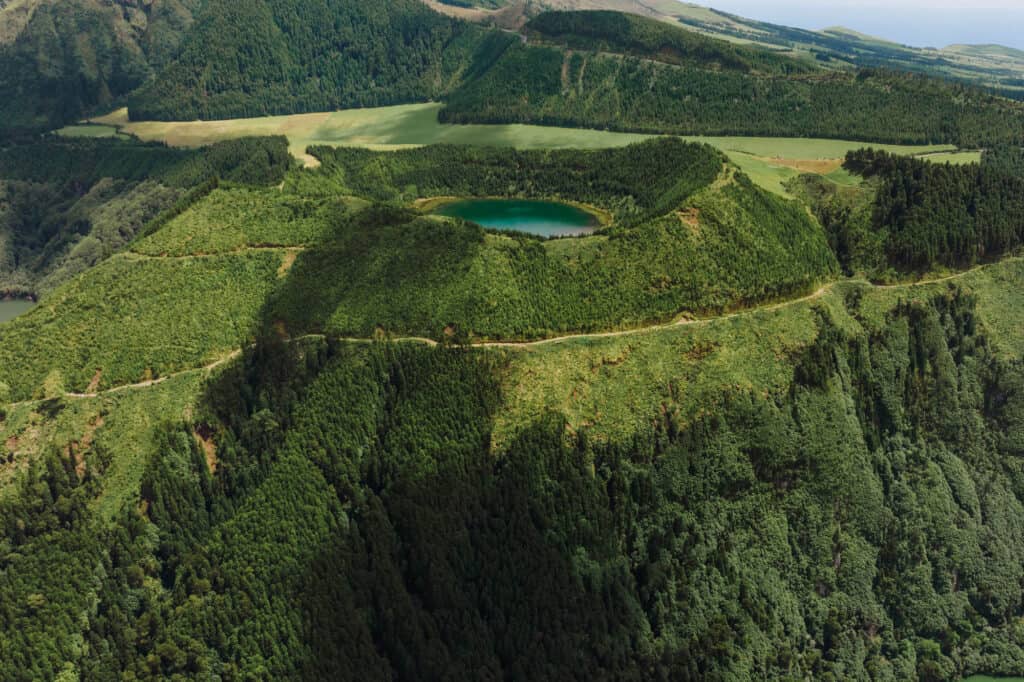
The Azores in June
June marks the beginning of the peak tourist season in the Azores. While the islands are more vibrant and lively, you’ll find larger crowds at popular attractions, and hotels will be in high-demand.
The Azores Islands will be in full-bloom in June! The hydrangeas will be bushy and blooming along the highways and trails.
The daily temperatures will rise into the 70s (Fahrenheit), and rain showers will become less likely. June offers perfect weather for outdoor activities, especially hiking around the volcanic landscapes.
Plus, you’ll have more time to experience it all, since the days are long, with hours of extra sunlight in June!
If you’re visiting the Azores in June, search for flights months in advance if you’re looking for a deal. Plus, be sure to book a hotel in advance, and a rental car in advance, especially if you’re looking for an automatic transmission.
The Azores in July
Visiting the Azores in July offers amazing outdoor experiences. The weather is warm, with average daily temperatures ranging from 20°C to 25°C (68°F to 77°F). It’s the month that draws the largest crowds to the islands, and it’s easy to understand.
July is still an excellent month for whale watching in the Azores. You can spot various whale species, including sperm whales, as well as dolphins and other marine life. Plus, the temperature of the Atlantic Ocean pops up into the 70s (Fahrenheit), making it the best time of year to go swimming and snorkeling.
The flowers are still blooming, and the views are stunning in July.
On the downside, you’ll find bigger crowds at the trailheads and on the beaches. Plus, hotels are bound to cost more and you’ll need to reserve your rental car in advance.
The Azores in August
Visiting the Azores in August is enjoyable, though possibly less green (weather-dependent). It’s still the peak of the summer tourist season, and the weather is still generally warm, with temperatures ranging from 21°C to 26°C (70°F to 79°F). It’s a perfect time for enjoying the hikes and beaches.
The water temperature in the ocean remains mild, so it’s the best time for swimming and snorkeling in the Azores.
As is the case in June and July, you’ll want to book flights, hotels, and rental cars in advance, if possible.
August can sometimes be drier, so parts of the islands may have less greenery compared to the spring and early summer months. Still, the viewpoints will be stunning!
You might also be able to be there for the grape harvest at the Azores vineyards. Sao Miguel is home to Quinta da Jardinette, a family-run winery which offers tours and tastings of a variety of wines.
The Azores in September
September is one of the best times to visit the Azores for two main reasons:
- The weather is still mild.
- The crowds are smaller.
The average temperatures in September range from 19°C to 24°C (66°F to 75°F), making it a perfect time to explore the Azores hiking trails, waterfalls, and beaches.
The Atlantic Ocean around the Azores is still relatively warm, so it’s still a good time for swimming and snorkeling. The waves won’t be as large as they are in the winter, but you’ll still be able to surf on some of the beaches, like Santa Barbara on Sao Miguel.
While September is still a popular time to visit the Azores, kids are back in school and European summer vacations are over. The crowds will be much smaller at the trailheads, and flight prices from the USA will start to drop.
The Azores in October
You’ll still have a good time visiting the Azores in October, but expect the temperatures to drop and the number of daylight hours start to restrict the time you spend outside.
It’ll be a more tranquil experience, since tourist crowds will be reduced.
The weather can be more unpredictable, with a mix of sunny and rainy days. Average temperatures range from 17°C to 22°C (63°F to 72°F) in October, so it’ll still be mild during the daytime.
October brings changing colors to the Azores’ landscapes, so it’ll be the best time to check out the fall foliage on parts of the islands.
Plus, it’s still a good time to hike the trails, though they might be wetter and muddier in October.
The Azores in November
November marks the beginning of the winter season in the Azores. The weather can be cooler and wetter, with average temperatures ranging from 15°C to 20°C (59°F to 68°F).
Some years, the fall foliage will extend into November, and the weather is still mild enough to enjoy the viewpoints and hiking trails. While the weather is unpredictable, you can always count on the Azores hot springs to be full of warm geothermal water.
The main perks of visiting the Azores in November are the same for any of the winter months: smaller tourist crowds and discounts on lodging.
The Azores in December
Visiting the Azores in December offers a unique and enjoyable experience, as long as you’re aware of the challenges. It never snows in the Azores, but the weather will be much cooler and rainier.
During the winter, average temperatures range from 12°C to 17°C (54°F to 63°F). Plus, keep in mind, the daylight is limited in December, so you’ll have fewer hours to explore the natural scenery.
On the “plus” side, December is the off-peak tourist season, so you’ll have smaller crowds at the trailheads, and lower prices at the hotels.
Plus, the hot springs and thermal spas remain hot year-round!
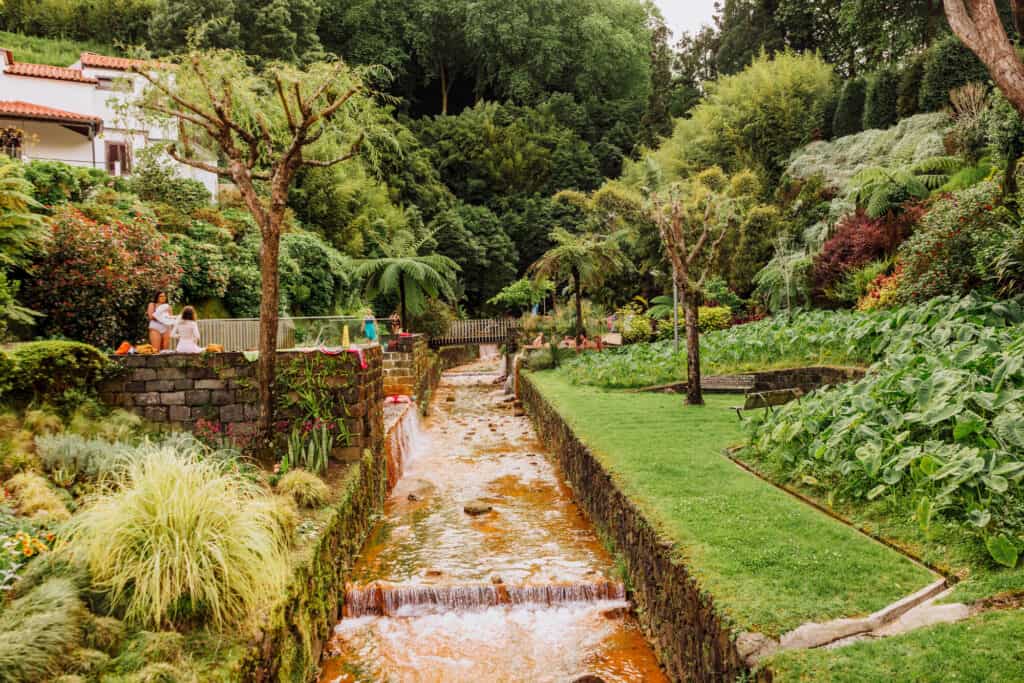
FAQs on When to Visit the Azores
Let’s tackle some of the frequently-asked-questions about visiting the Azores. Many of these are already answered up above.
Is there a rainy season in the Azores?
There’s no defined rainy season in the Azores, but the months from October through February tend to be wetter compared to the rest of the year. You can expect more frequent rain showers from the late fall through early spring, but even during these months, you’ll have many sunny days.
Does it snow in the Azores?
I asked several longtime residents of Sao Miguel if it ever snows, and all of them said: no! Several laughed at the question!
The Azores’ higher peaks, like Pico Mountain on Pico Island, are the most likely areas to see snow, but it would likely just be a rare dusting at higher elevations.
Is there a hurricane season in the Azores?
The Azores are rarely impacted by hurricanes, even though they’re in the Atlantic Ocean, where hurricane season peaks in August and September. At times, the storms have followed paths which have taken them close to the Azores.
What’s the cheapest time to visit the Azores?
If you’re looking for the best deals on flights, fares start to drop (usually) by mid-September. They remain lower, especially if you fly midweek rather than on the weekends, through the spring.
Hotel prices dip late in the fall, and remain low through the winter months.
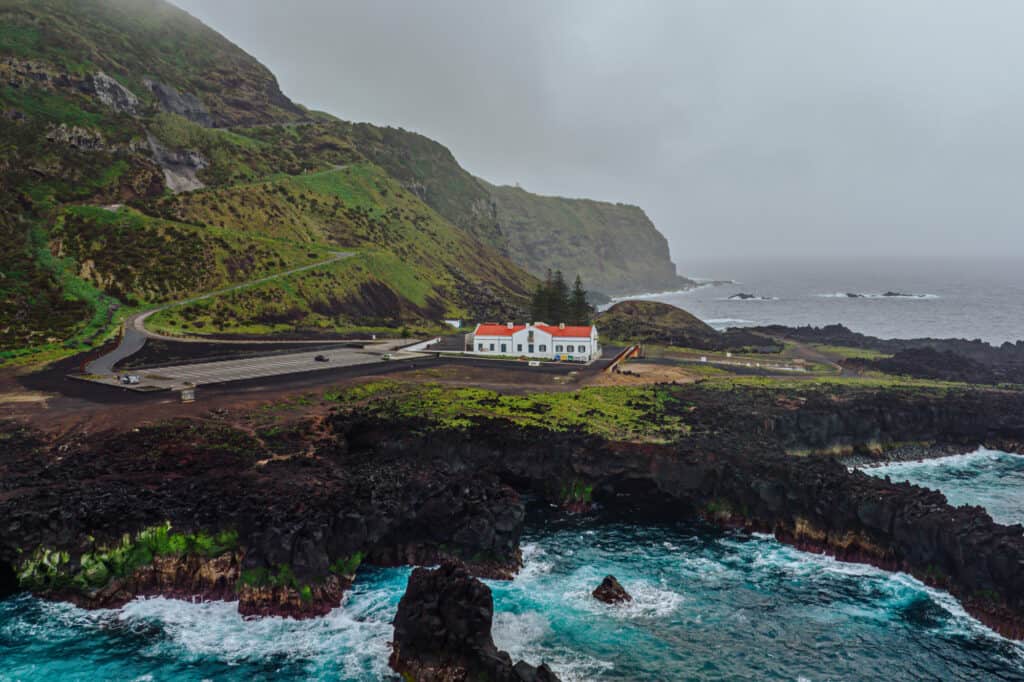
Wrap: Best Time to Visit the Azores
This is a lot of information and statistics about everything from air temperature to water temperature to rainfall. Keep in mind: the weather is unpredictable, so the expectations and averages are never guaranteed.
In general, you’ll be able to get the most out of a visit to the Azores in the late spring, before the summer travel season, and the early fall, after most tourists have gone back to work and school.
If you’re already in Europe on a trip, the Azores are about a two-hour flight away. I’d still consider taking a weekend trip in the winter to relax in the hot springs or spend a peaceful couple of days at a spa!
CHECK OUT OUR OTHER GUIDES TO THE AZORES:
